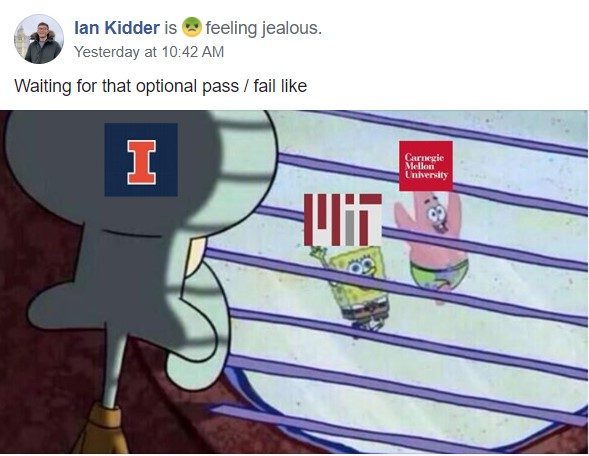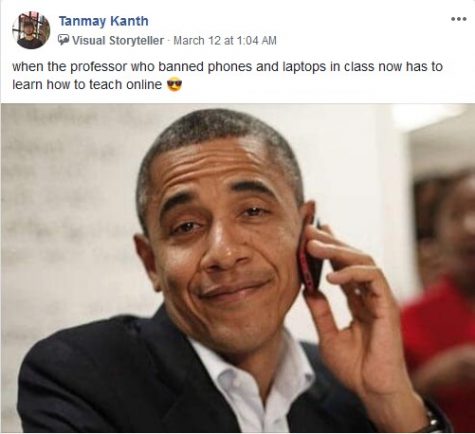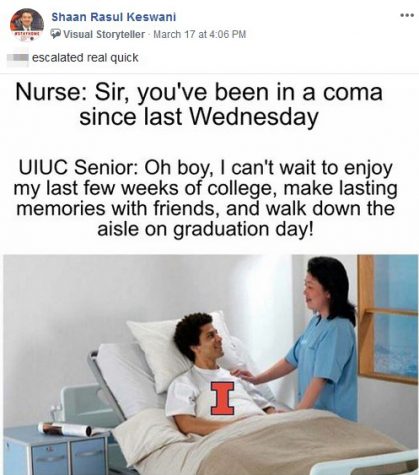Facebook meme page connects students amid virus

Screenshot Courtesy of Facebook
Ian Kidder posts a meme to the Facebook group “UIUC Memes for Underfunded Teens” on Saturday.
Mar 23, 2020
In the wake of social distancing efforts to combat COVID-19, college students are going to niche parts of the internet to connect with others. Some are opting to learn and post viral TikTok dances, others are hosting Zoom parties and many are turning to memes.
On a given week, Andy Zhou, senior in business and administrator for the UIUC Memes for Underfunded Teens Facebook page, said the page typically sees 134 reactions from its 33,000 members, with reactions including likes, dislikes or loves on posts). But the week of March 9 — the last week of in-person classes for University students — the page saw nearly 18,000 reactions which is over one hundred times over the average amount.

Zhou attributed the boost in the page’s engagement to an increase in material to post about the threat of school being canceled, the switch to digital learning and social distancing extremes.
College students nationwide are turning to memes as a way to connect with others. The Zoom Memes for Self Quaranteens Facebook page had over 175,000 members in less than a week from its creation, according to the page’s administrators.

David Cheng, senior lecturer at the Australian National University, has researched the effects of humor on the well-being of victims of workplace aggression. Applied to trauma more generally, Cheng said in an email that humor is an effective coping mechanism because it evokes positive emotions, distracts from negativity and “gives us a sense of control.”
“So by laughing at something, even though we may not be able to change the situation itself, we can change the situation in our mind by maybe thinking of it as being less dangerous or us as being more powerful,” he said. “In this way, in our mind, at least, we are taking back some control, and this can be psychologically helpful.”
Get The Daily Illini in your inbox!
Coronavirus memes can be an effective way to disseminate information to young people, according to news outlets. However, they can also be a culprit for spreading misinformation and even bigotry.
Harmful COVID-19 memes targeted at people of Asian descent were spreading, according to Vice.
Timothy Hale, professor in AHS, studies digital inequalities and health disparities. He said these memes can circulate even more depending on social media algorithms and how people choose to curate their individual newsfeeds.
“Memes and other information shared online have a virus-like quality in how it spreads through social networks,” he said in an email. “Our online social network often closely matches our offline network and reflects the social structural conditions in which we were raised and currently live (i.e., family background, education and income level, neighborhood).”
Spencer D.C. Keralis, a digital humanities librarian at the University, conducted a study about the prevalence of cat memes throughout history. Keralis explained the social responsibility users have when it comes to sharing memes of any kind.
“Memes can be really great for sort of letting off steam and sharing sort of light-hearted things, but like any kind of media, it depends on the user,” he said. “If the user has the intent to share bad information or to say something racist, then the meme is bad.”

Keralis said memes are more than just the photos with the white impact font written on it; he said memes are “any bite-sized piece of culture that gets duplicated and shared widely,” which included propaganda posters and jingles before social media.
Zhou said different meme formats do well on different platforms. He said we are living in the label-meme era, the still picture with text written over it, and these are the “types of memes [that] go nuclear on Facebook because the entry to make them is so low.” On Reddit, he said there are different communities that push users to innovate, so a meme’s life cycle is much shorter.
In regards to coronavirus memes, Zhou said wholesome memes, while informative, are less likely to get the same type of results as a meme that pokes fun. He said this is because “a lot of memes fall into derogatory humor, making fun of something, taking a jab at something.” He also said funny but sensitive posts about the new normal are the best type of memes to make.
Zhou said coronavirus alone does not explain the surge in page reactions. He and the other on-campus administrators started Munch Madness, a C-U restaurant tournament for members to participate in, to boost engagement. He also said there is always a spike in engagement around midterms because students are procrastinating. However, he said the page is more active when school is in session, and this spring break saw more engagement than a typical break, probably due to social distancing.
For seniors who are graduating and out-of-state students who abruptly returned home, Zhou said the page can be “their conduit to the U of I community.”
Keralis said memes can be a way for people, not just students, to connect.
“I think that’s a way of sort of creating empathy and sharing this experience while we’re socially isolated, we still have social media to reach out to each other, and memes are one way to acknowledge our discomfort in being alone together,” he said. “I think they have a good social function in that regard: Even though we may be socially distant, we are not alone in this experience.”






